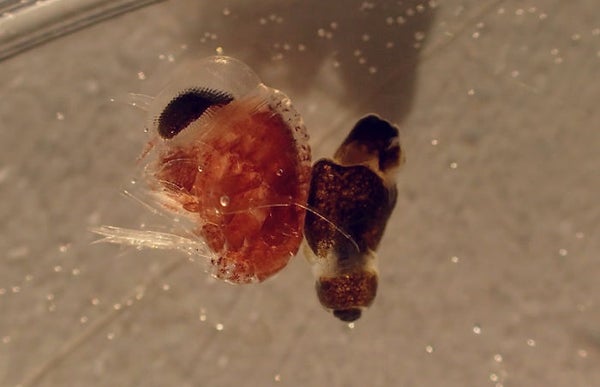This article was published in Scientific American’s former blog network and reflects the views of the author, not necessarily those of Scientific American
The following sobering fact goes a long way toward explaining the hijinx that follow: in under-ice waters, a majority of predatory fish in one major Southern Ocean suborder had the tiny crustacean Hyperiella dilatata in their stomachs. Hyperiella dilatata is tasty.
So they have taken measures. The only sensible thing to do, really. They bodily abduct foul-tasting pteropods called Clione limacina antarctica and wear them like backpacks to ward off fish. They hold on to those pteropods with their sixth and seventh pereopods for dear life, clinging to them even if they are also holding on to a large clutch of their own eggs, even after several days in an aquarium, even after being killed and fixed with preservative. That, my friends, is what we refer to as a death grip.
Amphipods are tiny marine crustaceans that look a bit like shrimp. They eat detritus or scavenge for a living. Pteropods are free-swimming gastropods sometimes called sea butterflies or sea angels. Lacking external shells, some have turned to chemical defense.
On supporting science journalism
If you're enjoying this article, consider supporting our award-winning journalism by subscribing. By purchasing a subscription you are helping to ensure the future of impactful stories about the discoveries and ideas shaping our world today.
Here's some video of an amphipod styling with its much-smaller pteropod in tow:
Such pteropods deter fish in two ways. They must taste bad, because if a fish eats a pteropod-packing amphipod, it spits them both out. Clione produces a chemical called pteroenone that is suspected to be the source of the revulsion. But the sharp-eyed fish can also learn to recognize the sight of an armed amphipod and will actually turn tail and swim away. Mmmmm …. I don’t think so.
Pteropod-napping behavior was first described back in 1990 in McMurdo Sound in the Ross Sea off Antarctica. Up to 74% of Hyperielladilitata swimming around there sported a pteropod safety pack. Recently, a team of German scientists wondered how common the behavior was outside of Antarctic shelf waters and sampled the open waters of the Southern Ocean at 30 locations between 45° and 71°S.
The answer is: much less common, but not unheard of. They discovered another pteropod-stealing species much farther north: Hyperiella antarctica nabs Spongiobranchaea australis. But for all their time spent dragging plankton nets through the water, they only found four examples of backpacking out of 342 amphipods captured. One of them, however, was located at 45°S latitude, much closer to South Africa than Antarctica and far further north than ever noted before. This amphipod boldly sported a pteropack 2/3 of its own size.
It’s possible that many of the amphipods ditched their pteropods on being caught up in plankton nets, the authors noted. But given amphipods’ demonstrated reluctance to drop their payloads, it seems more likely the low occurrence of the behavior is real, and that the vast open spaces of the open ocean are simply less dangerous than the crystal-clear confined waters of shallow McMurdo Sound.
Even within the sound, the 1990 study found that the proportion of amphipods carrying pteropods was much lower further offshore (6%) than nearshore (up to 74%). Whether that is because predators can see them better in the shallower, clearer water, or because there are simply fewer predators in deeper water remains unknown.
The amphipods carrying pteropods were also found at stations where amphipod abundance was much lower than other stations, which suggests that pteropod abduction might be a response to intense predation pressure.
How the pteropods feel about this whole arrangement is not known. As they are imprisoned on an amphipod’s back, it seems unlikely they can eat. It is known they can survive for up to a year without a meal, a feat remarkable in and of itself, so perhaps becoming someone else’s anti-predator accessory isn’t as much of an inconvenience as you’d think. You do get a free ride out of the deal. And, luckily for both parties, the pteropod’s pteroenone production is not based on its diet, so starvation doesn’t necessarily impair its ability to deter fish. Unluckily for the pteropod, it makes no chemicals that deter amphipods.
Reference
Havermans, Charlotte, Wilhelm Hagen, Wolfgang Zeidler, Christoph Held, and Holger Auel. "A survival pack for escaping predation in the open ocean: amphipod–pteropod associations in the Southern Ocean." Marine Biodiversity (2018): 1-10.
